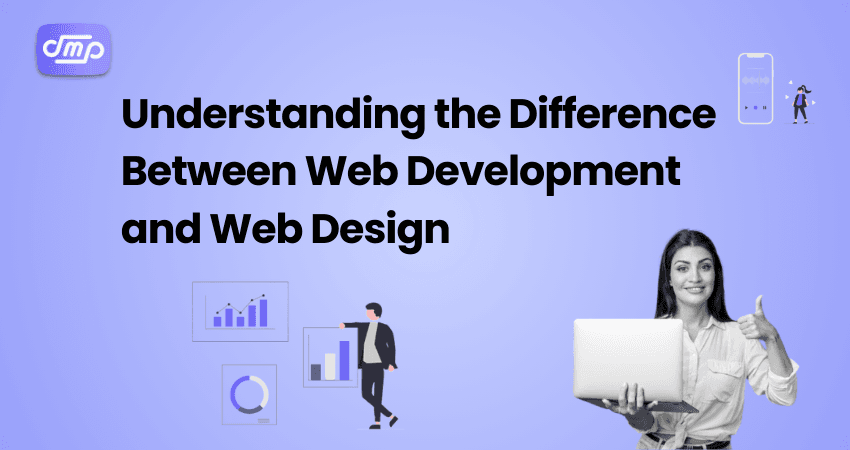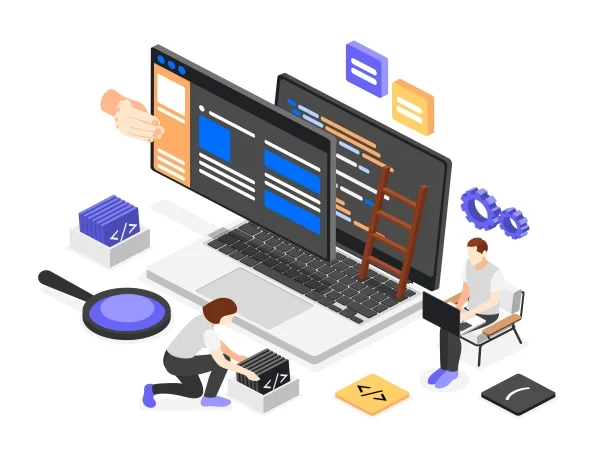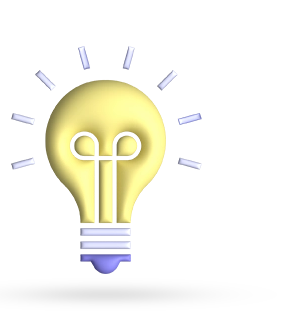
- May 19, 2025
- Digital Marketing, website design
- Web development
Table of Contents
Understanding the distinction between web development and web design is critical because these two jobs serve very different functions when creating a website. Web design focuses on the visual appearance and user experience, whereas web development brings those designs to life through code and functionality.
Knowing the distinction helps you:
- Select the appropriate specialist or service for your needs.
- Create realistic project goals and schedules.
- Improve communication with developers and designers.
- Avoid common misunderstandings and budget overruns.
In short, having this knowledge makes the website design process go more smoothly and successfully, whether you’re a client, creator, or collaborator.
What is Web Design?

Web design refers to the visual and aesthetic aspects of a website. It concerns how a website seems, feels, and interacts with visitors. A web designer’s job is to design a layout that is not only visually appealing, but also useful and intuitive.
Key responsibilities include designing the layout, color scheme, and overall visual style
- Developing wireframes and mockups
- Emphasis on user experience (UX) and user interface (UI).
- Ensure brand uniformity on all web pages.
Common tools used include Figma
- Adobe XD
- Sketch
- Photoshop/Illustrator
- Canva (for simple visual materials)
Core skills include visual design principles
- UI/UX Design
- Typography, color theory, and spacing
- Prototyping and responsive designs
Basic understanding of HTML/CSS (optional but useful)
Create a visually appealing and intuitive experience that engages people while remaining consistent with the brand’s identity.
What is Web Development?
Web development includes the coding and technical implementation of web designs. The designer’s layout is transformed into a fully functional website by developers, who use programming languages and frameworks.
Types of web development:
- Frontend development is concerned with the visible aspects of a website (buttons, forms, and layout).
- Backend development focuses on server-side components such as databases, APIs, and site functionality.
- Full-stack development entails both frontend and backend skills.
Common tools and languages include HTML, CSS, and JavaScript
- React, Angular, and Vue (frontend)
- PHP, Python, Node.js (backend)
- WordPress, Shopify, and CMS systems.
- GitHub, Visual Studio Code, and Terminal
Core skills include writing clean and efficient code.
- Integrating third-party services (e.g., payment gateways and APIs)
- Debugging and Problem Solving
- Website optimization (performance, speed, and SEO).
- Understanding database and server environments.
- Create a safe, scalable, and high-performing website that works seamlessly across all devices.
How Web Development and Web Design Work Together
Web development and web design are two independent professions, yet they are inextricably linked and must work together to build a successful website. Amazing design without utility is simply a picture, while amazing code without a meaningful layout will not attract users.
- Collaborative Workflow: Discovery and Planning: Designers and developers collaborate with stakeholders to identify project objectives, target audiences, and brand identity.
- The Design Phase: Wireframes, mockups, and visual prototypes are created by the web designer using tools like Figma and Adobe XD. Designers think about user experience (UX), visual hierarchy, mobile responsiveness, and branding.
- Development Phase: Once the design has been accepted, the developer will take over. Frontend developers use HTML, CSS, and JavaScript to create code from the design. Backend developers operate on the server side, ensuring the functionality of forms, databases, and content management systems.
- Testing and Optimization: Both designers and developers work together to assess user flow, mobile responsiveness, speed, and accessibility. Iterative feedback ensures that the finished website looks and performs properly.
- Launch and Maintenance: Developers manage deployment and continuing updates. Designers may work on improvements, new page designs, or marketing initiatives.
- Why Collaboration Matters: Effective communication reduces rework and confusion. Ensures that the design vision is implemented correctly. The seamless integration of images and functionality increases usability and engagement. Smoother handoffs and teamwork shorten project deadlines.
Which One Do You Need?
Your project’s goals and stage will determine whether you hire a web designer, a web developer, or both. If you want to create a brand identity, create a new layout, or improve the visual appeal and user experience of your website, you’ll need a web designer. Designers focus on the site’s look and feel, producing layouts, color schemes, and user-friendly interfaces that are consistent with your brand. If you already have a design and need to bring it to life with code, add new functionality, fix problems, or improve performance, you should engage a web developer. Developers handle the technical components of the site, who ensure that it runs smoothly, is responsive, and has all of the necessary features. Larger initiatives, such as launching a new website, constructing an e-commerce platform, or doing a total redesign, will most likely require both. Working with both ensures that your site looks great and performs properly, resulting in the optimum user experience.
Career Paths in Web Development & Web Design
Web development and web design provide a diverse range of job prospects that cater to a variety of abilities and interests, whether you prefer creative expression or technical problem-solving.

Career Paths in Web Design
Web design occupations focus on the visual and experiential aspects of websites and digital products. As a web designer, you can begin as a junior UI (User Interface) designer, creating buttons, icons, and layouts that help people navigate a website. Another prominent option is UX (User Experience) design, which entails conducting extensive research on user behavior, wireframing, prototyping, and testing to ensure that websites are intuitive and suit user demands.
Experienced designers frequently specialize further, becoming interaction designers (who focus on how users interact with a product) or visual designers (who focus on branding and aesthetics). Others may become product designers, managing the full design process of digital products from concept to launch.
With appropriate expertise, web designers can advance to leadership positions such as creative director or design manager, where they lead design teams and influence the overall visual strategy of businesses or clients.
Career Paths in Web Development
Web development occupations are ideal for people who enjoy coding and creating the technological foundation of websites. Developers are generally classified into three major categories:
- Frontend Developers: These experts employ programming languages such as HTML, CSS, and JavaScript to construct everything that consumers view and interact with on websites. They ensure that the design is responsive, dynamic, and accessible across all devices.
- Backend developers: PHP, Python, Ruby, and Node.JS are common languages used by those who work on the server, database, and application logic. They build the infrastructure that processes data, manages user authentication, and links to other services.
- Full-Stack engineers: These flexible engineers can handle both frontend and backend work, making them especially useful in smaller teams or startups where wearing several hats is frequent.
Beyond coding, developers frequently advance to positions such as DevOps engineers, who manage website deployment and scaling, or technical leads, who oversee development teams and architectural decisions. Senior developers may also advance to positions such as software architects or Chief Technology Officers (CTOs).
Freelance and Entrepreneurship
Freelancing is popular among both web designers and developers since it allows for freedom and the ability to work on a variety of projects. Successful freelancers can establish large client bases by specializing on areas such as e-commerce, mobile apps, or corporate websites. Some professionals eventually start their own firms or digital studios, offering complete web solutions that include design and development services.
Education Paths and Skill Development
Both sectors can be entered through formal education, such as degrees in computer science, graphic design, or digital media, but self-learning and online courses are also popular. Certifications in UX design, coding bootcamps, and platforms such as Coursera, Udemy, and freeCodeCamp enable aspiring professionals to swiftly gain in-demand skills.
It is critical to keep up with emerging technology, design trends, and code frameworks. Participating in groups, contributing to open-source projects, and creating a personal portfolio or GitHub repository are all effective approaches to demonstrate knowledge.
Job Market and Demand
The demand for competent web designers and developers is high, as businesses of all sizes require excellent websites, apps, and digital experiences. According to industry statistics, web development positions are expected to rise substantially faster than average, while UX/UI design employment will also expand rapidly due to the growing emphasis on user-centered digital goods.
Conclusion
Understanding the distinction between web development and web design is critical—whether you’re launching a new website, considering a career in technology, or simply want to work more successfully with digital marketing and SEO professionals. Web design realizes the creative vision through images, layout, and user experience, whereas web development creates the technical structure that makes the design usable and interactive. Though they serve different functions, these two disciplines are inextricably linked and perform best when aligned.
Choosing the correct path—designer, developer, or both—is determined by your individual aims. If you’re creating a brand, user experience and visual attractiveness will be your primary concerns. If you’re concerned with performance, features, or functioning, development takes precedence. In most successful online projects, a website is brought to life by the joint efforts of both areas.
Whether you’re launching a digital product, employing professionals, or pursuing a new career, understanding these responsibilities will allow you to make better decisions, communicate more effectively, and ultimately produce greater digital results.











